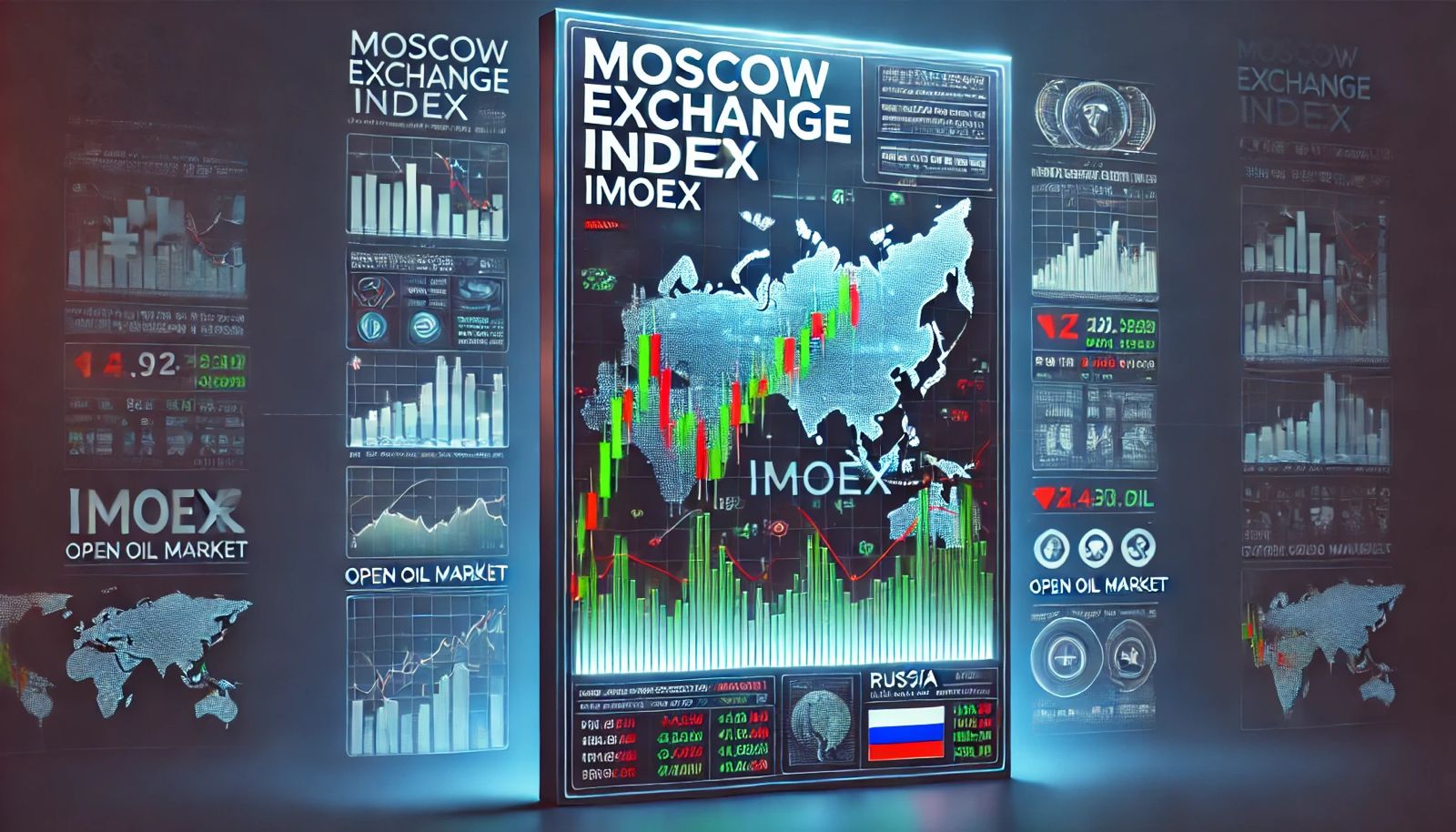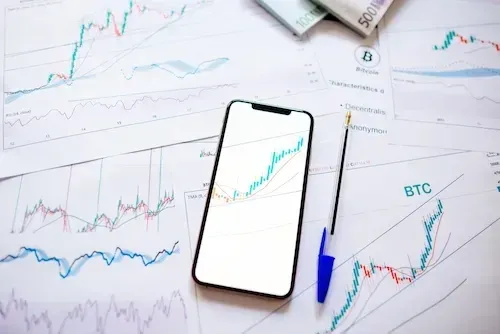MOEX Index (IMOEX): What is it?
The Moscow Exchange Index (IMOEX) is a fundamental indicator that reflects the dynamics of the stock prices of the 50 largest and most liquid companies traded on the Moscow Exchange. It represents a free-float weighted average of the prices of these stocks. IMOEX is a key indicator of the state of the Russian stock market and serves as an important tool for market analysis, investment decision-making, and assessing the effectiveness of investment portfolios. Its value is calculated in real-time during the main trading session. It is important to note that IMOEX is a price index, which means it reflects changes in stock prices rather than their fundamental value. This index, previously known as the MMVB index, provides investors with valuable information regarding the overall trend in the Russian stock market, allowing them to assess risks and potential investment returns. Furthermore, the dynamics of IMOEX influence the general perception of the state of the Russian economy and the attractiveness of investments in Russian assets for both domestic and foreign investors.
-
IMOEX is a key indicator for assessing the state of the Russian stock market.
-
It is calculated based on the 50 largest and most liquid companies.
-
The index takes into account the market capitalization of stocks considering free float.
-
The value of IMOEX is calculated and updated in real-time.
-
IMOEX serves as a tool for analyzing market conditions and making investment decisions.
Definition and Brief History of IMOEX
The Moscow Exchange Index (IMOEX) is a capitalization-weighted index that reflects the price dynamics of the largest Russian companies traded on the Moscow Exchange. It is the primary benchmark for the Russian stock market, allowing an assessment of its overall condition and development trends. IMOEX was initially created as the MMVB index (International Interbank Currency Exchange), the historical predecessor of the Moscow Exchange. Its calculation began in 1997, reflecting the then-composition of leading companies on the Russian market. In 2017, due to the reorganization of the Moscow Exchange and changes in market structure, the index was renamed to IMOEX (MOEX), while retaining the main calculation methodology. Throughout its history, IMOEX has consistently adapted to changes in the Russian market by reviewing the composition of companies included and the calculation methodology to ensure its maximum representativeness and accuracy.
-
IMOEX is a capitalization-weighted index based on stock prices.
-
Its predecessor was the MMVB index, introduced in 1997.
-
In 2017, the index was renamed to IMOEX after the reorganization of the Moscow Exchange.
-
The composition of companies and the calculation methodology of IMOEX are regularly reviewed.
-
IMOEX serves as a key indicator of the state of the Russian stock market.
Historical Dynamics of IMOEX: Trend Analysis
An analysis of the historical dynamics of the IMOEX index allows for the identification of long-term trends and cyclical fluctuations in the Russian stock market. For a comprehensive understanding, it is essential to consider several factors that significantly influence its value. Let's examine the key periods and trends:
-
Pre-2008: This period is characterized by overall growth, interrupted by short-term corrections. The dynamics were influenced by both global economic processes and internal factors, including oil prices and political stability.
-
2008-2009: The global financial crisis led to a sharp decline in the index, reflecting the negative impact on the Russian economy. Recovery occurred gradually.
-
2010-2014: A period of relative stabilization and growth, largely driven by high oil prices and increased investments.
-
2014-2016: Geopolitical tensions and falling oil prices caused a significant decrease in the value of IMOEX. Sanctions from Western countries also had a negative impact.
-
2017-2022: This period is characterized by volatility associated with fluctuations in oil prices, internal economic reforms, and geopolitical events. Both growth and correction periods were observed.
-
2022 to present: Geopolitical events, sanctions, and adjustments in the developmental strategy of the Russian economy have had a significant impact on dynamics.
Calculation of IMOEX: Methodology and Components
The calculation of the IMOEX index is carried out by the Moscow Exchange based on a sophisticated methodology that considers several key parameters. The foundation is a free-float weighted method, which means that the weight of each company in the index is determined not only by its market capitalization but also by the share of stocks available for free circulation in the market. This excludes the influence of stocks owned by the state or major shareholders on the overall dynamics of the index, making it a more accurate reflection of market sentiment.
The calculation process includes the following stages:
-
Composition determination: The IMOEX index includes shares of the 50 largest and most liquid Russian companies selected based on strict criteria regularly reviewed by the Moscow Exchange. Selection criteria include market capitalization, liquidity, financial stability of the companies, and other factors.
-
Calculation of weight coefficients: A weight coefficient is determined for each company, proportional to its free-floating market capitalization relative to the total market capitalization of all companies in the index. This ensures the correct reflection of each company's influence on the overall index value.
-
Real-time index calculation: Throughout the trading session of the Moscow Exchange (from 10:00 AM to 6:50 PM MSK), the index is continuously calculated based on current stock prices of the constituent companies and their weight coefficients. Data is updated with high frequency, providing investors with access to current information.
Thus, the IMOEX index represents a dynamic and precise reflection of the state of the Russian stock market, built on a strict methodology and a regularly updated composition of stocks from the most significant Russian companies.
Composition of IMOEX
The composition of the IMOEX index is based on strict selection criteria that ensure representativeness and relevance of the index for the Russian stock market. It includes shares of the 50 largest companies leading in market capitalization and liquidity. The process of forming and reviewing the composition is conducted by the Moscow Exchange regularly to reflect changes in the structure of the Russian economy and the securities market. To be included in the index, companies must meet a range of requirements regarding the volume of free-floating shares, liquidity level, and trading history. The weight of each company in the index depends on its market capitalization considering free float. This ensures an accurate reflection of changes in the stock prices of the largest Russian companies and avoids distortions related to the presence of controlling stakes. The review of weights occurs regularly, usually several times a year, to maintain the relevance of the index and its relevance for investors.
-
IMOEX includes shares of the 50 largest Russian companies.
-
Selection criteria include market capitalization and liquidity.
-
The weight of each company is determined by its market capitalization considering free float.
-
Composition and weights of companies are reviewed regularly.
-
The goal is to ensure the representativeness of the index for the Russian market.
Criteria for Selecting Companies in the Index
The selection of companies for inclusion in the IMOEX index is conducted based on strictly defined criteria that guarantee the representativeness and reliability of the index as a reflection of the state of the Russian stock market. The selection process is transparent and regularly reviewed. Key criteria include:
-
Market capitalization: Companies must have sufficient market capitalization to ensure adequate trading volume and liquidity of stocks. This is crucial for the stability and reliability of the index.
-
Free float: The share of stocks available for free market circulation is taken into account. A high free float value ensures accurate reflection of market prices and minimizes distortions related to controlling stakes.
-
Liquidity: Stocks of companies included in the index must have high liquidity, meaning the ability to buy and sell quickly and efficiently without significant price fluctuations. This is critical for accurately reflecting market dynamics.
-
Trading volume: The average daily trading volume of stocks over a certain period is considered. A high trading volume confirms investor interest and liquidity of the asset.
-
Sectoral diversification: The composition of the index aims for a balanced representation of different sectors of the Russian economy to exclude disproportionate influence of certain industries on the overall index value.
-
Financial reporting: Companies must provide transparent and high-quality financial reporting to ensure investor trust and data reliability used in the index calculation.
The regular review of the index composition allows adaptation to changes in the market and ensures its relevance and relevance.
Weight of Companies in the Index and Their Review
Each company included in the IMOEX index has a specific weight that reflects its share in the overall index volume. This weight is calculated based on the market capitalization of the company considering free float. Free float is the share of stocks available for free market circulation, excluding stocks owned by the state, major shareholders, and other insiders. The higher the market capitalization considering free float, the larger the company's weight in the index. This means that changes in the stock prices of companies with a larger weight will have a greater impact on the overall index value than changes in the stock prices of companies with a smaller weight.
The composition of the IMOEX index and the weights of companies in it are regularly reviewed by the Moscow Exchange. This is done to ensure that the index accurately reflects the current market state and the leadership of the largest companies. The review process typically occurs twice a year, and decisions on inclusion, exclusion, or possible changes to the weight of companies are based on objective criteria, including market capitalization, liquidity, and other significant factors. Information about the review of weights and the index composition is published in advance on the official website of the Moscow Exchange, allowing investors to adapt their investment strategies timely.
-
The weight of a company in IMOEX is determined by its market capitalization considering free float.
-
Regular review of the composition and weights of companies ensures the index's relevance.
-
Selection criteria for companies include market capitalization, liquidity, and other factors.
-
Information on reviews is published in advance on the Moscow Exchange website.
How to Use Information about IMOEX
Information about the Moscow Exchange Index (IMOEX) can be used by various market participants to make informed decisions. An analysis of the dynamics of IMOEX allows for:
-
Assessing overall market conditions: An increase in the index signals positive investor sentiment and rising stock prices of leading Russian companies, while a decline suggests the opposite. This provides insight into the general state of the Russian stock market.
-
Making investment decisions: The value of IMOEX and its dynamics can be used to develop investment strategies. For instance, an increase in the index may indicate a favorable time to buy stocks, while a decline may suggest selling or switching to more conservative assets.
-
Evaluating the performance of investment portfolios: Comparing the return of an investment portfolio with the dynamics of IMOEX allows assessment of its effectiveness relative to the overall market. Underperformance compared to the index may indicate portfolio inefficiency, while outperforming it may signify good results.
-
Conducting technical analysis: Charts and historical data on IMOEX are used for conducting technical analysis, enabling predictions of future index dynamics and making trading decisions based on it.
-
Identifying trends: Long-term analysis of IMOEX dynamics helps determine overall market trends and assess the prospects for growth or decline in the stock market.
Analysis of Index Dynamics and Its Importance for Investors
Analyzing the dynamics of the IMOEX index is an integral part of making informed investment decisions. Understanding trends, identifying periods of growth and decline, and recognizing factors influencing changes in the index's value are critically important for investors. Positive IMOEX dynamics generally indicate growth in the market capitalization of the companies within it and increased overall investor confidence in the Russian economy. Conversely, negative dynamics may signal adverse economic forecasts, geopolitical risks, or other factors diminishing the attractiveness of the Russian market for investment.
For investors, it is important to monitor not only the absolute value of the index but also its changes over time. Short-term fluctuations may be caused by various factors, including short-term speculation. However, long-term trends allow for assessing the overall direction of the Russian stock market and making corresponding investment decisions. For example, an increase in the IMOEX index may indicate favorable conditions for investing in Russian stocks, whereas a decline may serve as a signal for diversifying the investment portfolio or re-evaluating the investment strategy.
-
Tracking the dynamics of IMOEX allows assessment of overall market trends.
-
Analyzing long-term trends aids in making strategic investment decisions.
-
Short-term fluctuations may be driven by speculative factors.
-
Understanding factors impacting IMOEX is crucial for risk minimization.
-
The dynamics of IMOEX affect the investment attractiveness of Russian assets.
IMOEX as an Indicator of the State of the Russian Stock Market
The Moscow Exchange Index (IMOEX) serves as the most comprehensive and objective indicator of the state of the Russian stock market. Its dynamics reflect overall investor sentiment, the influence of macroeconomic factors, and changes within specific sectors of the economy. An increase in IMOEX indicates optimistic expectations regarding the future development of the Russian economy and the attractiveness of Russian stocks for investment. Conversely, a decline in the index indicates a predominance of pessimistic sentiment and potential market risks. Analyzing the dynamics of IMOEX allows investors to assess the current market situation, identify trends, and make more informed investment decisions. It is important to note that IMOEX is not an absolute indicator, its value can be distorted by short-term fluctuations and the impact of external factors. Nevertheless, the long-term dynamics of IMOEX serve as an important tool for strategic investment planning and assessment of the effectiveness of investment strategies.
-
IMOEX reflects overall investor sentiment in the Russian stock market.
-
An increase in IMOEX signals optimistic forecasts regarding the Russian economy.
-
A decline in IMOEX indicates a predominance of pessimistic sentiment.
-
Analyzing the dynamics of IMOEX helps assess the current market situation and identify trends.
-
IMOEX is an important tool for long-term strategic investment planning.
Investing in IMOEX
Investing in IMOEX provides investors with the opportunity for diversified investments in the largest Russian companies. There are several ways to invest in this index, minimizing risks and maximizing potential returns:
-
Exchange-Traded Funds (ETFs): ETFs that track IMOEX offer a straightforward and effective way to invest. They replicate the index's composition, allowing investors to gain exposure to the entire market without purchasing shares of each company individually.
-
Mutual Investment Funds (PIFs): Many asset management companies offer PIFs that invest in the stocks of companies included in IMOEX. Management of such funds is entrusted to professionals, which can reduce risks for inexperienced investors.
-
Direct investment in stocks: Investors can independently create a portfolio of stocks included in the IMOEX. This approach requires a deeper understanding of the stock market and can yield higher returns with the right risk management. However, it is more complex and requires more time.
The choice of investment strategy depends on individual goals and the investor's risk tolerance level. It is essential to thoroughly examine the documentation and consult with specialists before making any investment decisions.
Ways to Invest in the Index (ETFs, Mutual Funds)
Investment in the Moscow Exchange Index (IMOEX) is accessible through various financial instruments that allow for diversifying risks and obtaining returns correlated with the index's dynamics. The most common methods are investments in exchange-traded funds (ETFs) and mutual investment funds (PIFs).
-
Exchange-Traded Funds (ETFs): ETFs that replicate the IMOEX index allow investors to purchase and sell shares in a portfolio of stocks corresponding to the index's composition. Trading of ETFs occurs on the exchange, ensuring high liquidity and transparency. Investments in ETFs represent a relatively simple and accessible way to obtain returns correlating with the growth of the IMOEX index.
-
Mutual Investment Funds (PIFs): PIFs that invest in stocks of companies included in the IMOEX index offer a more diversified approach. Management of such PIFs is conducted by professional managers, which can be appealing for investors who prefer not to create their investment portfolio independently. However, the liquidity of PIFs may be lower than that of ETFs.
The choice between ETFs and PIFs depends on individual investment goals, risk tolerance levels, and investor preferences. ETFs are generally preferred by investors seeking simplicity and high liquidity, while PIFs may be more suitable for those preferring professional management of their portfolio. Before making an investment decision, it is advisable to consult with a financial advisor.




